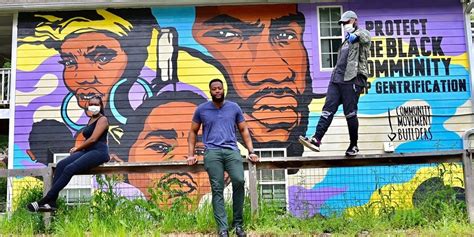
The issues on availability of housing in Black and Brown communities continues to be significant. During our first season we first highlighted how COVID impacts Black home ownership. Then, we followed up with an episode on the banking systems complicates loss of housing. Now, Professor Audrey McFarland focused on gentrification, which is a significant issue today. We we want to offer some resources on surviving gentrification.
Gentrification: What is it?
ThoughtCo has a very well written and understandable piece on the subject. Gentrification “is generally considered to be the process by which traditionally lower-income neighborhoods are transformed—for better or worse—by an influx of higher-income residents and more profitable businesses.” As the authors point out the factors that make our communities become impoverished and sustain that poverty also make them attractive to developers. The developers see the properties as viable for tearing down and rebuilding to attract a more affluent community.
Banks, developers and elected officials work hand in hand in this process, often ignoring the needs and voices of poor people who live in the targeted communities. And as Professor McFarland pointed out when the areas are redeveloped there is a a risk of cultural disruption and loss. Here’s a video from Tank and the Bangas that expresses the fear of cultural loss.
What Can Communities Do to Prevent Being Displaced
The key take away from the professor was that communities have to get involved in the process very early. In fact They need to get involved before they get targeted. Establishing Community Land Trusts was one suggestion. This one is particularly good for stabilizing housing. A community land trust (CLT) is a structure that allows land to be held “in trust” for community need. The land sits outside of the influence of market pressures. Housing on a CLT can be bought and sold but only at prices that keep it affordable for others in the community. They can also be used for rental property.
How Can We Invest In Our Communities Without Creating Displacement?
Gentrification is often a function of so called Community redevelopment. How then, can communities participate in the community development process to help prevent the gentrification and cultural displacement? One of the best answers is become involved, or start, a community reinvestment project. In a previous post we listed information about the Community Reinvestment Act (CRA) and a sample agreement to be used with a developer to help ensure community needs are met. Check here for that post. Black women in Philadelphia are providing a powerful example of what community led organizing can do. The Women’s Community Revitalization Project started when a group of women challenged their bank’s compliance with the CRA. Two hundred and eighty-two housing units later, they have the reputation of being innovative developers. What a remarkable story! Read about them here.
Though it may be a struggle to take control of what happens in our communities, we can do it. Let’s preserve the housing we have and control what gets built around us.